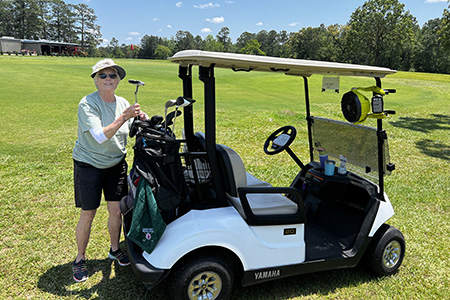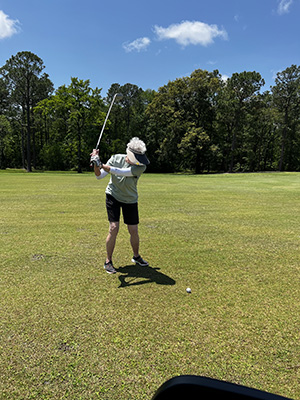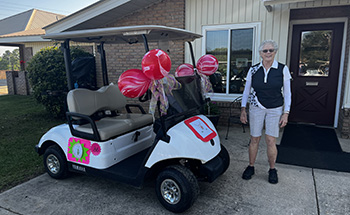Written by: Kiara Harris
 Vibrant. Active. Energetic. Sarah Hazen’s loved ones use these three words to describe her.
Vibrant. Active. Energetic. Sarah Hazen’s loved ones use these three words to describe her.
At 85 years old, Hazen spent her time swinging her clubs at golf courses all over Alabama. If she was not on the links, friends and family might find her traveling across state lines to visit her grandchildren or spending time at the beach.
Hazen was on the move and enjoying life, when suddenly, things changed.
Within six months, her energetic routine slowed down dramatically. She began to experience shortness of breath, difficulty bending over, and an inability to walk more than twenty feet without resting. Even daily tasks had become challenging to complete. Her symptoms were not only persistent, but also progressive, which caused her to give up her favorite hobby, golf.
“I could just tell that every-so-often, I would be a little weaker and a little shorter of breath,” remembered Hazen.
Hazen and her daughter Trina spent months trying to figure out what was causing such a drastic decline. Since Hazen was a previous open-heart surgery patient, they knew it was time to check her cardiovascular health.
She consulted with a team of UAB cardiologists including Jose Tallaj, M.D., Tom McElderry, M.D., and James Davies, Jr., M.D. Physicians referred Hazen to the UAB structural heart team for further evaluation.
In January 2023, she arrived for an appointment with interventional cardiologist, Mustafa Ahmed, M.D., associate professor in the UAB Division of Cardiovascular Disease.
The team used an echocardiogram to evaluate the blood flow in Hazen’s heart. The results revealed that her symptoms were caused by a degenerative bio prosthetic aortic valve. Hazen was diagnosed with aortic insufficiency and stenosis — conditions that cause the heart to enlarge and weaken, affecting its ability to pump blood to the rest of the body.
Ahmed informed Hazen that her condition was cause for concern, but that he may be able to perform a Transcatheter Aortic Valve Replacement (TAVR) procedure. During this minimally invasive procedure, physicians place an artificial valve in the aortic valve to open the pathway. The procedure is ideal for patients who are considered high risk for surgery.
Concerned about the fragility of Hazen’s previous valve, Ahmed advised her to go home, think about what he said, and consult with her family. He told her that while she did that, he would continue to assess if she was a suitable candidate for the procedure.
Hazen assured Ahmed that no further consultation was necessary. “I told him I wasn’t going back home until it was done!” recalled Hazen.
Ahmed called the next day to inform Hazen that the procedure could be done on January 13, just one day before her 86th birthday.
“That’s wonderful!” Hazen exclaimed. “That will be my birthday present.”
The Procedure
On January 13, Sarah Hazen was prepped and ready for her procedure.
In a special operating room, a multidisciplinary team from the UAB Medicine Cardiovascular Institute (CVI) used X-ray guidance to advance the catheter through the blood vessel and position the replacement valve. The procedure took roughly an hour and a half from start to finish.
“I woke up in the recovery room and the first thing I said was, ‘Whoa, I can breathe!’” laughed Hazen.
Hazen stayed at the hospital overnight for observation. She was discharged from the hospital on her 86th birthday. Following her discharge, she spent time at her daughter’s home, where she discovered her ability to walk up the stairs again, a task she had not done in quite some time.
She was back on the golf course by March.
The Aftermath
In May, her daughter hosted the “Sarah’s Heart Pumping Classic Golf Tournament” where eight women from across southeast Alabama joined Hazen for a game of golf. This time it was not shortness of breath that stopped her and her friends, it was the heat.
time it was not shortness of breath that stopped her and her friends, it was the heat.
“The doctors told me I didn’t need to overextend myself by getting hot,” said Hazen.
By September, she had entered a three-day golf tournament in Biloxi, Mississippi. She and a friend successfully played all eighteen holes each day for three days.
“For her to be in a wheelchair and not feeling her best to being up walking and telling me she could outwalk me with no problem is just amazing to see,” said outpatient Advanced Practice Provider Madison Robson, CRNP.
“It is incredible that in this day and age, we can use such a minimally invasive technique to provide a definitive fix for a problem which allows restoration of quality of life and independence regardless of someone's age,” Ahmed said, “In this case, TAVR provided an 86-year-old who is absolutely full of life and just wanting to do the things that make her happy and maintain her independence with a treatment option that allowed her to come one day and go home the next day.”
Though Hazen’s results were transformative, experts caution that results vary from patient to patient. To assure optimal outcomes, all patients receive an aftercare plan which includes a referral to cardiac rehabilitation — a medically supervised program designed to improve cardiovascular health through exercise training, education, and heart monitoring.
It has been a year since Hazen's procedure and she is growing stronger every day. Not only is she back on the golf course, but she is also back to traveling across state lines to see her grandchildren. Hazen has two trips planned in May. She will be headed to Salt Lake City, Utah as well as playing in another tournament in Golf Shores.
 Hazen goes to the gym three times a week to build her strength and improve her balance. She is thrilled to be back to herself and enjoying her favorite activities around town.
Hazen goes to the gym three times a week to build her strength and improve her balance. She is thrilled to be back to herself and enjoying her favorite activities around town.
“Let me just say one thing, God did a miracle on me by empowering Dr. Ahmed and his team to perform this high-risk procedure on me successfully. The UAB team is the cream of the crop! I trust them completely. They are wonderful, and I’m glad we have them!” concluded Hazen.
UAB Cardiovascular Institute was the first clinic in Alabama to perform the minimally invasive TAVR procedure. The Institute is now recognized as the state’s leader, performing more than 2,400 procedures since 2012. The program is nationally ranked by U.S. News & World Report.
If you would like to learn more about this program, visit the website.